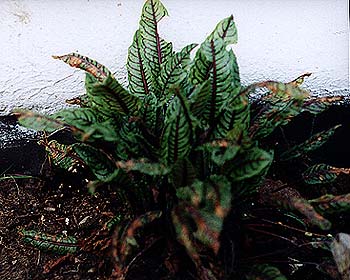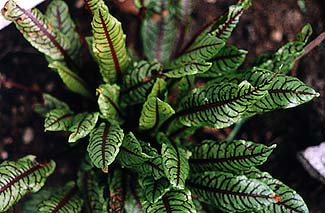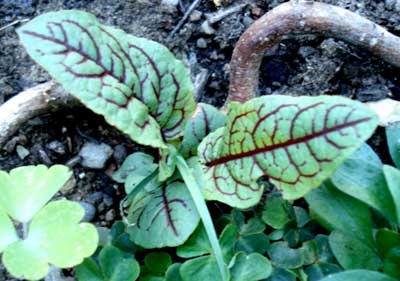 The Macabre Beauty of
The Macabre Beauty of
Bloody Dock
"It was a queer little garden & puzzling to a stranger, the few flowers being put at a disadvantage by so much greenery; but the discovery was soon made that Mrs. Todd was an ardent lover of herbs, both wild & tame."
-Country of the Pointed Firs
by Sarah Orne Jewett
(1849-1909)
Bloody Dock (Rumex sanguineus var sanguineus) is named for the blood-red veins in its green fronds. It is also called Bloodwort, Bloody Wood Dock, or for those who don't want to evoke the macabre, Red-Veined Dock.by Sarah Orne Jewett
(1849-1909)
In the Puget Sound region, it is thought to be best used as a container-plant that can be brought into shelter during winter, or grown as a harvested crop that won't have to make it through the winter. But ours did fine for three years in the garden sheltered by other plants, until I decided it had gotten a bit weedy so I harvested it for salads.
 A couple years later, a Bloody Dock popped up in our garden by itself, obviously seeded from some other garden in the neighborhood (third photo below is of that young volunteer). So it seems darned hardy to me.
A couple years later, a Bloody Dock popped up in our garden by itself, obviously seeded from some other garden in the neighborhood (third photo below is of that young volunteer). So it seems darned hardy to me.It is from the Mediterranean region & Africa, & reputedly does not like much of a winter chill. But I planted that first one near a buttercup winterhazel sheltered by an overhanging window, against the wall where it got residual heat from the house, plus morning sun. Spring & summer of its first year it was in splendid form, & come Fall it still seemed okay.
For its first Winter, it seemed to have gone to sleep but remained evergreen & pleasant; it did not die back from the cold. Late winter got rather harsh, however, & the Bloody Dock finally did get raggedy around the tips, as can be seen in the topmost March portrait just before Spring. But it was still okay even after late freezes, & it bounced back as quick as the weather got pleasant, as is already evident in the second portrait taken nearer the end of March.
 For a warm-region plant, however, it does not like a drought. Before I figured out it needs perpetually damp soil, I would now & then see it at the height of summer wilted & laying its leaves down flat on the ground, looking for all the world to be expiring of heat prostration & already beyond salvation
For a warm-region plant, however, it does not like a drought. Before I figured out it needs perpetually damp soil, I would now & then see it at the height of summer wilted & laying its leaves down flat on the ground, looking for all the world to be expiring of heat prostration & already beyond salvationBut with a good watering, the leaves sprang right back up lively & bright. It was planted too near the house to get rained on, so toward the end of summer I moved it to a damper location, where it quickly tripled its thickness & practically begged to have a little of itself harvested for salads.
It produces two to three-foot stems for its loose star-shaped blossoms that begin pale green & turn reddish brown. The blooms are not as pretty as the blood-striped leaves, & if it is permitted to go to seed, the leaves will become rangy; eventually the entire plant will stop being a compact one-foot leafy clump, but grow tall & stringy.
Yet by removing the June-July blooms, the plant does not grow tall & thin, but uses its energy to produce more & more of the basal leaves, keeping itself fresh & bushy. So I clip the flowers to keep it a tight leafy plant, though if I had two or three of them, I'd let one of them take its own course, as it easily self-propagates from its own seed. If lots of them were popping up in the garden until there were just too many, that'd just mean I could harvest more for salads.
Really only the youngest leaves are edible raw. They taste like spinach or chard, &and add considerable color to a salad. It is worth growing a row of them in a vegetable garden as a food crop, though the leaves do quickly toughen & would have to be chopped rather small for stir-fry.